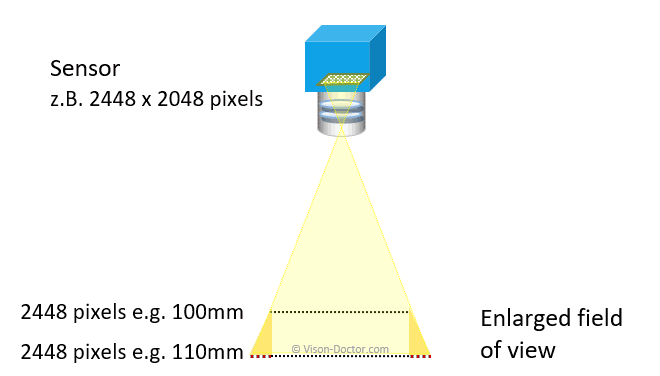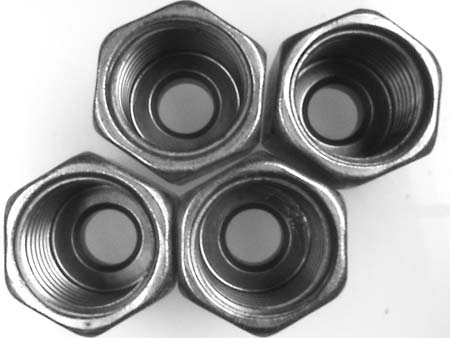Entocentric Lenses
Entocentric lenses are the most commonly used lens types. Fixed focal lengths, but also zoom lenses are based on this optic principle and correspond to the human perspective. An entocentric normal lens has a fixed aperture angle of the optics towards the object as well as towards the sensor. In case of entocentric zoom lenses, the aperture angles are variable.
Lenses with an aperture angle similar to the human eye are referred to as normal lenses. They have an aperture angle of approx. 50 degrees, the sensor diagonal corresponds approximately to the focal length. According to the aperture angle, lenses are differentiated into various classes:
 |
Characteristic features of entocentric lenses
Objects of equal size which are closer to the optic centre (and thus closer to the camera) are depicted larger. If they are further away, they are depicted smaller.
 |
Even when using fixed focal lengths, the object range to be detected can be adjusted quite well in this way: with an increased working distance, the image detail becomes larger, when reducing the distance, it becomes smaller.
 |
The larger the aperture angle (or the smaller the focal length), the larger is typically the geometric distortion. This is caused by imaging a semi-spherical optic space into the plane two-dimensional level of the camera sensor. Expensive lens designs with aspherical lens elements can reduce this effect.
 |
This effect that in the centre of the image the object is looked at vertically whereas more and more at an angle towards the picture margin, can be very disturbing in case of wide-angle lenses.
Lens with 25mm focal length
Lens with 6mm focal length
Precise measuring cannot be guaranteed in such pictures, especially if the parts cannot be supplied exactly. However, fisheye lenses serve to inspect the inside of a bore or the sides of a part. Yet, extreme focal lengths and very short working distances are required for this purpose.
Typical fields of application of entocentric lenses
Entocentric normal lenses are used for most fields of application like presence and placement checks, pick-and-place applications, print image inspections, colour applications, OCR and barcode reading.
Entocentric lenses are rather unsuitable for measuring tasks and the inspection of very small image details (macro and microscope optics). Either telecentric lenses or macro optics are used for this purpose. If, nonetheless, simple measuring tasks are to be realised using non-telecentric lenses, it is generally recommended to use lenses with rather long focal lengths and to increase the working distance. A perspective absolutely parallel to the optical path without the effects described above is only provided by telecentric lenses.
Adjustment possibilities on the lens
Except for extreme wide-angled and fisheye lenses, entocentric lenses usually provide two adjustment options.
- By means of the aperture ring, the required focal aperture can be adjusted, thus influencing the image brightness and depth of field but also the compensation of optical image faults.
- The focus ring serves to focus the image. Correct focusing is possible up to the minimum object distance (MOD) determined by the manufacturer.
Further information can be found in chapter "Optic basics"; helpful online wizards for calculating the required focal length, working distances, aperture angles, etc. can be found in chapter "Service - Optical Calculations"
Important for machine vision
- Pay attention to a high optic quality of your lenses. They should be capable to copy fine structures on the sensor. Above all, the pixel size of the camera sensor is decisive. The smaller the pixels, the higher the resolution of the optics must be!
- Apochromatically corrected lenses are especially suitable for colour applications and/or illumination using white light (avoidance of chromatic aberration). Even for IR or UV applications there are specially corrected lenses, the lens design and anti-reflection coating (spectral transmission) of which are adapted to special wavelengths.
- Absolutely mandatory for industrial applications are lenses with set screws in order to avoid accidental misadjustment of the optics.
- A screw-in type filter thread should principally be available on the front side of the lens. In this way it is easy to mount polarising filters, colour filters, etc. in order to suppress interfering influences. Exceptions are often extreme super wide-angle and fisheye lenses with strongly convex front lenses which usually make it impossible to mount a filter.









